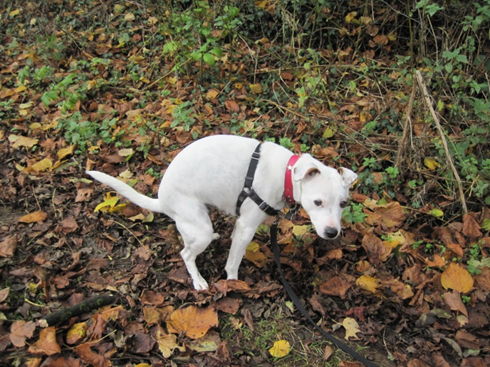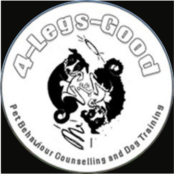By ‘pet waste’ I mean excrement and bedding, here I talk mainly about dog and cat waste but there is also rabbit and guineapig bedding. In areas where there has already been some success in reducing domestic waste, pet waste can be as much as 11% cat litter/bedding and 4% pet excrement of the waste stream by proportion. Dogs do about a 1000 tonnes a day (the sun newspaper).
Looking at reducing this waste is an interesting subject area as there are many factors to be considered. There are lots of reasons why it’s advisable to pick up after your dog and dispose of dog and cat waste responsibly and I attempt to explore them here.
No article about disposal of pet waste would be complete without including parasites. I’m going to assume that it’s obvious to you why we need to effectively keep our pets parasite free and to not to spread them to others. This makes effective disposal of pet waste desirable in itself.
Dog fundamentals – always pick up, apart from anything else, it is the law. Clearing up is advisable even in remote places, as poo can spread disease to other species and any chemical wormers present in dog poo will destroy soil organisms wherever you are.
When picking up using a biodegradable poo bag will be a good start – these are easy to get. If using the ‘paper method’ when house training your puppy use newspaper not ‘puppy pads’, newspaper is already in the waste stream, doesn’t contain plastics and is fully biodegradable. You wouldn’t be able to recycle it afterwards but should be able to put it in your garden waste bin. That’s if you can get it! Ubiquitous newspaper, has become rare. However, I have just discovered you can now get biodegradable puppy pads.
Cat fundamentals:
Another obvious place to start would be to use an easily recyclable litter substrate. These days there are cat litters describing themselves as environmentally friendly – these tend to be made from old newspapers and other by-products. However, not all cats like this kind of substrate as it is not naturally what they would chose to toilet on (sand, soil or gravel being more natural for cats). In addition, most of this ‘by-product’ cat litter will end up back in the bin and back in the waste stream – although they could be composted..
Soil or compost (make sure you use peat-free) are choices which make perfect litter substrate for most cats as they feel more natural under the cat’s paws and can be easily returned to the environment – just remove the solids and put on your garden! Although cats become programmed to toilet on the substrate that they are used to, most cats would likely adapt quite readily to soil or compost because it is close to a natural substrate i.e. soil.
The solids are a little more difficult. Safe disposal of cat solids is essentially the same as safe disposal of dog solids.
Although indoor cats will usually toilet in a litter tray, most owners of outdoor cats don’t know where they toilet. Cats bury their waste. They tend to like newly worked earth and sand including, or especially it would sometimes seem, children’s sandpits. One way to manage this is to provide cats with an outside toilet, making it very favourable to them to encourage use (e.g sheltered, hidden, close to the house, natural soft soil/sand substrate, clean). This would require regular removal of solid waste.
Other poo-borne pathogens….
In addition to worms, whilst researching this topic I have also thought about other potential pathogens present in cat and dog faeces. Doing a regular ‘worm count’, and if necessary, worming our cats and dogs will deal with regular tape and round worms – see article on ‘wormers and fleaers’.
Chemical wormers need to be kept to a minimum because they get into the soil and destroy soil organisms. The recent penchant for vet corporations to make money out by introducing monthly pet clubs time tabling monthly chemical treatments for fleas and worms is increasing the damage done to the soil be chemical wormers. It’s much more environmentally-friendly to worm only when your pet actually has worms. Stool samples can be sent off for assessment; you need then only worm if worms are present (www.wormcount.com). There are very effective non-chemical wormers available and keeping your pet healthy by boosting their own immunity and the addition of certain herbs to the diet will help fend off parasites (see article on ‘wormers and fleaers’).
Parasitic worms such as round worm Toxicara cansis and Toxicara cati and tape worms (Cestoda spp) produce oocysts which survive in the environment, lying dormant until a suitable host comes along. Whilst tape worm and round worm are easily dealt with by wormers, there are also single cell protozoans parasites which produce resistant cysts similar to those of the round and tape worms but which are not treatable by regular worming. If infected, your pet is unlikely to have any symptoms and you wouldn’t know that they were infected. Whilst these parasites may not be directly harmful to your pets or yourselves, they may go on to do harm to livestock and wildlife at a another stage of their lifecycle. Some of these protozoan pathogens also specifically require dog or cat hosts. For example, Neosporosis which can cause abortion in cattle and Sarcocystitis which can cause neurological disease and death in sheep, both have to cycle through the dog. Good reasons to pick up dog poo on grazing land.
Other pathogens found in poo include unfriendly bacteria such as E.Coli. However, whilst dangerous when first released into the environment these single cell pathogens quickly denature and become harmless.
As you can see, there are many pathogens present in poo, however for the purposes of this article and to demonstrate the issue surrounding safe disposal of poo, I’m going to focus on the fascinating (if horrifying) life cycle of the parasitic protozoan, Toxoplasmosis gondii (not toxicara the round worm) which cycles through the cat.
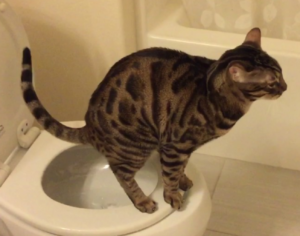
Toxoplasmosis gondii
T.gondii’s primary host is the cat and it’s secondary hosts include humans, cattle, sheep, pigs, rodents and birds. Following the initial infection, the host tends to be asymptomatic. T.gondii is not easy to treat, but most people with a healthy immune system suffer no ill effects. The most serious issue in humans is if a woman suffers an acute infection during pregnancy, which can result in foetal blindness. There is also an issue of a dormant infection becoming active where the individual is immune-compromised such as with Aids.
Following a successful immune response, dormant parasites remain encysted in the host tissues for years as tachyzoites. They can be found in any organ, but are most commonly found in the brain, skeletal muscle and heart muscle.
The life cycle is completed by cats eating infected animal tissue. Infectious oocysts are excreted by the cat for up to two weeks after the initial infection and can survive in warm, moist soil for more than one year. Let’s not just blame the cats, the majority of humans are infected by eating under-cooked meat rather than by cat faeces.
16-40% of the human population in the United States are infected with T.Gondii and it is likely that a similar proportion of the UK’s population is infected (http://www.patient.co.uk/doctor/toxoplasmosis). Interestingly, studies have reported subtle changes in behaviour, personality and psychomotor performance in infected individuals. Essentially, T.Gondii changes host behaviour, for example, infected rats will take greater risks making them more likely to be caught by cats. In this way, T.Gondii can get back into the cat and breed.
Research by Flegr (J1 et al 1996 J) suggests that the parasite can even change human behaviour with infected people more likely to take greater risks! Initially peers were sceptical but recently more research has backed up the findings.
To ensure that any cat faeces is free of Toxoplasmosis Gondii Oocytes, the faeces must be heated to 66°C for 10 minutes, or be in the environment and unable to access it’s host for at least 12 months in order to be deactivated while raw meat must be frozen or cooked to make it safe to ingest.
Disposal of dog and cat faeces: I’ve had a look at quite a few ideas aimed at dealing with dog and cat poo. Hopefully, the information below will help you decide which option is best for your circumstances. Any chemical wormers that are present in dog and cat poo will adversely affect soil health.
Worming needs careful consideration as any residues will be present in faeces. Wormer residue will kill soil organisms and isn’t beneficial anywhere in the environment and any compost produced from pet waste won’t be beneficial for the soil. Ask your vet how long the ‘active ingredients’ stay active and be super sure to bin poo until that time has elapsed – see article about worm and flea treatments
Shropshire council have told me that the contents of dog waste bins are mixed with litter bins collected from streets. From 2008 dog waste was declassified as hazardous and therefore enabled to be landfilled along with litter. The dog poo in your wheelie bin goes the same way. Shropshire council advises bagging and binning. As land fill sites are left to sit for some time after decommissioning, this must be a fairly safe way to dispose of dog and cat poo. In Shrewsbury this will probably be incinerated where it may contribute to the generation of a very tiny bit of electricity.
Flushing: Severn Trent informed me that sewage treatment aims to remove pathogens via sludge treatment and digestion route where temperatures exceed 40-50oC but that there is a small risk of eggs passing into sewage sludges. Sewage sludges are now used on agricultural land which I think is great. Although this should be a fairly safe way of disposing of dog and cat faeces increasingly, raw sewage is pumped into our rivers in large quantities on a regular basis so all of the above risks that apply to catching pathogens from dog and cat faeces apply to catching pathogens from the raw human sewage that is put out into our environment!
Bringing home your dog poo to flush away presents practical problems. There are many so-called ‘flushable’ poo bags these days, but the water providers are dead against these. I purchased some and tried them for the benefit of this article but they failed to flush. Also if you are littering your cat on soil or compost it is perfectly possible simply to flush away the solids but you will have an unsightly residue of soil or compost in your toilet bowl.
There is a product called a Doggybog – designed to fit onto your outdoor soil pipe. You just put the dog/cat waste down the pipe and the waste flushes away into the mains sewage system. This is potentially quite useful.
Composting: It is unlikely that a domestic compost heap will have sufficient bulk and in the correct combination in order to get hot enough to destroy pathogens that may be present in dog or cat faeces. For example, to ensure that any cat faeces is free of Toxoplasmosis Gondii Oocytes, the faeces must be heated to 66°C for 10 minutes.
Different composting systems use different pathogen markers e.g. ABPR uses salmonella or e Coli mostly & require either 5 hours at min 57 0 C with a max particle size of 50mm or 1 hour at min 70 0 C with a max particle size of 60mm followed by a “storage” period of 18 days when it can’t be applied. The EU standards require 1 hour at min 70 0 C max particle 12mm with no post pasteurisation treatment. From our earlier discussion relating to T.gondii this will be sufficient to kill it however, it is unlikely that a domestic heap will get hot enough.
The only way to check if T. gondii is likely to be destroyed is by putting a thermometer into the pile. This will ensure the system is not hit and miss and that the temperature throughout the pile is hot enough (or not) to destroy pathogens. Unless the user has a dedicated approach to the activity, parasitic or pathogenic material is likely to escape destruction.
Pet Poo Wormery: These work in exactly the same way as a normal wormery used for kitchen waste, but should only be used for animal waste. The worms must be fed exclusively on pet waste as they will not tolerate a mixed diet – the manufacturers say a separate wormery to recycle kitchen scraps is needed. These systems will not destroy pathogens and the manufacturers advise that the compost created not be used on food crops.
Dog poo septic tanks: There is lots of advice on the internet for making your own ‘dog poo composter ‘ or you can buy a purpose built septic system for breaking down dog waste e.g. The Doggie Dooley.
These are essentially bottomless buckets buried in the ground with stones for drainage with a lid on top. You add the dog/cat faeces as it accumulates and you also need to add septic tank activator (enzyme). They will not destroy resistant, encysted pathogens such as T.gonii and T.cansis and cati. However, if this material is not disturbed it should become relatively harmless after 12 months.
Combined compost/natural wormery: Our friend and permaculture guru, Steve Jones (http://www.sector39.co.uk/) has a plastic dustbin dug into the ground with holes in the bottom to give a good connection with the underlying soil. Dog (and/or cat) faeces is added from the top with saw dust. Over time, this makes a rich mulch. The pooey goodness spreads out through the bottom and into the soil. It doesn’t need spreading – the worms transport it. Steve has only emptied his ‘compost’ or ‘natural wormery’ dog poo bin once in two years. He put the newer material through a hot composter to ensure it was safe before spreading.
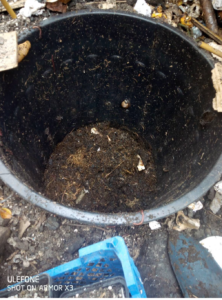
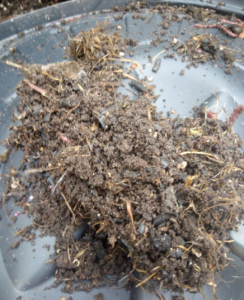
More recently, Steve has been adding charcoal (biochar) to the mix resulting in the goodness coming from the dog (or cat) faeces going up another level. The biochar is a bio-activation agent. The bio char is also sequestering carbon making the poo even more beneficial!
If you have relatively small amounts of poo, there would be no need to empty the bin. It will take the year to get out the bottom so any pathogenic cysts will have ceased to be.
We need to see the potential in poo! I have mostly been talking about dog and cat waste but we keep half a dozen or so guinea pigs in the garden bedded on straw (or currently rape straw). We compost the cleanings out with allotment waste and kitchen waste. It’s our secret weapon at the allotments – the envy of all. The guinea pigs effectively give us a ‘closed system’ of fertility.
Generate electricity: This has been done experimentally using a small methane generator to power a street light in parks. This is a cool idea to run the lighting of a park off the dog poo deposited in the park! This is unlikely to be practical unless there is sufficient volume of poo although of course, dog poo would work in conjunction with human poo to generate electricity and there is plenty of this!. https://asunews.asu.edu/20120501_dogpark
http://www.youtube.com/watch?v=ha8NiP6Y9lg
So:
- Use re-cyclable poo bags
- Litter your cat on soil or compost and separate solids to dispose of separately – return soil/compost to your garden
- Local authorities suggest putting it in landfill – but we want to reduce landfill
- Flushing is as safe as flushing human poo(!) but ideally without the ‘flushable’ bags. The ‘Doggy Bog’ waste pipe attachment could make flushing more practical.
- hot composting will do the trick but difficult on a domestic scale
- generating electricity is obviously the way forward but sadly may take some time for the technology to mature
- a septic tank or wormery system will deal with the waste and if the results are left undisturbed for a year after last used then this material should be safe
The law:
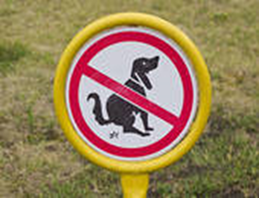
Is surprisingly complex but essentially:
- clean up after your dog where the legislation applies – almost everywhere. Pretty much all urban areas and some rural too
- show the means to do so i.e. have poo bags on you.
- it is an offence to not remove dog faeces from designated land exceptions kerbsides on 50mph+ roads, agriculture or woodland – (dependent upon management), most rural common land, and marshland
- fixed penalty up to £1000
There is a defence, but it can’t be that you didn’t notice and even not having a bag could lead to a maximum fine of £1000. Failing to clean up after an assistance dog can be a defence but not if you can e.g. being blind is a defence but deaf people must clean up even after their assistance dog.
Since the repeal of the dogs fouling of land act 1996, dog poo offences are either under a ‘public spaces protection order’ (pspo) on land ‘designated’ land so that these apply (came as Section 59 of the anti social, crime and policing act 2014), or under the clean neighbourhoods act 2005, on ‘undesignated’ land where there is no pspo.
Despite this difference, both pspo’s where they apply, and the clean neighbourhoods act where they don’t, both issue ‘dog control orders’.
However, if not otherwise designated, unless or until amended, there is land where either byelaws or the now repealed, 1996 act, still hold sway. After the 2005 clean neighbourhoods act, no new byelaws with respect to dog poo can be made and once a dog control order has been implemented that part of the byelaw is considered replaced.
Dog control orders:
- keep your dog on a lead
- put your dog on a lead if told to by a police officer, police community support officer or someone from the council
- stop your dog going to certain places – like farmland or parts of a park
- limit the number of dogs you have with you (this applies to professional dog walkers too)
The only one of these which always applies to (almost) everyone is number 5
- clear up after your dog and carry means to clean up
For the sake of the orders, primary authority is the county, district or borough council with secondary authorities also capable of issuing the orders including parish councils.
There is no legislation with respect to cat faeces as under law, cats are effectively wild animals.
The last turd...
